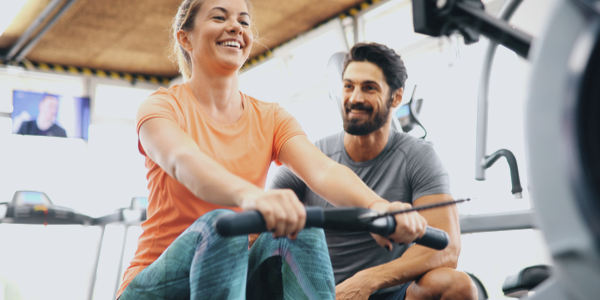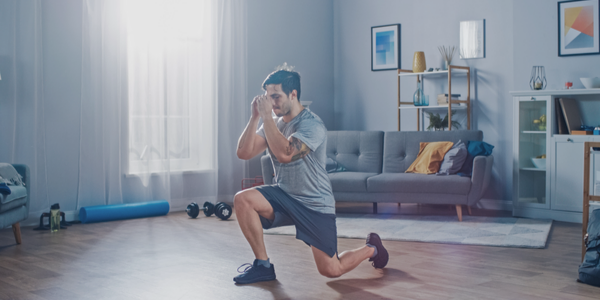
With so many available options these days, it can be confusing to find the best gym to join. On one hand, the fact there is something for everyone is great! On the other, it can be hard to discern the most important considerations that will lead to the most effective choice.
Fear no more, though! This article will cover the different styles of modern gyms and workouts and how to find the right gym for the long haul.
Different Types of Gyms
Nowadays, there is a gym for every type of exercise and fitness level with all types of classes. Whether a treadmill trekker, a spin fanatic, or a mindful yogi, there is undoubtedly one that works for everyone!
Of course, most people are familiar with the most common type of big box gym like Club Fitness, LifeTime Fitness, Planet Fitness, and the like. These gyms cover a wide range of features like cardio equipment, strength and conditioning machines and gear, stretching space, and more.
Most basic versions might only offer a few of each, while the higher-end options often provide luxurious features like spin rooms, saunas, spray tans, and massage chairs in addition. They normally offer group fitness classes and/or personal training as well.
The above is still the most typical kind of gym far and wide, but trendy types seem to arise every month. Some other popular types of gyms include the following listed below.
Spin/Cycle Bars
Cycle Bar, Soul Cycle, Fly Wheel are among some of the most popular spin studios. These "gyms" usually only feature guided spin classes at regular intervals. Some allow members to come in and cycle on their own, so be sure to check if that is an option. These tend to be costly are quite limited considering there are only spin bikes, but avid fans adore them, so this can be a solid option.
Yoga Studios
At least thirteen different styles of yoga exist and there is usually a separate studio for each, although some feature multiple kinds. Some of the most trendy include hot yoga, vinyasa, kundalini, bikram, and power yoga. They mainly differ in intensity and posing, so trying a variety and talking with employees of the studio can help determine which option is best.
Boutique Gyms
These facilities are similar to big box gyms, but are either further specialized or associated with a country club of sorts. The equipment is usually high-end and the price tag even more so. These tend to serve golfers, elite athletes, and celebs but if within budget, anyone can try them.
Boxing/Jiu jitsu/Taekwondo
Definitely more of a studio than a gym, these arenas vary based on what they offer. Obviously, boxing spaces will feature the large, hanging sandbags and "boxing fields", while Taekwondo gyms are mostly open spaces with matted flooring.
Because these are highly specialized workout methods, they tend to be more expensive than a regular membership. However, the individualized instruction is unparalleled.
CrossFit/Power Lifting Meccas
Crossfit gyms began emerging in the early 2000s nearly everywhere. Most of these gyms, sometimes called warehouses, feature equipment associated with the sport such as row machines, sandbags, and heavy tires.
Similar to spin studios, they usually offer timed classes at regular intervals. However, newer ones tout traditional gym spaces as well, making this a great option for those who want both.
Women's Only Personal Training Gyms
Many trainers recognized that some women just want to work out alongside other women, thus, exclusive training gyms began popping up in popular areas. From TRX to kettlebell classes to trampoline jumping workouts, there is most likely an appealing studio for all.
Again, these tend to be pricier than standard gyms, so ask for a female trainer at those if this style is not in the cards quite yet.
Rock Climbing
Recently popularized thanks to trendy cities like Boulder and Bend, there are entire gyms dedicated to climbing. These are a great unconventional option and for those who have climbing aspirations outside a gym. Most of the time, they do not feature any sort of standard gym equipment or space.
Class Pass
Intended for the indecisive, Class Pass is an application that allows one to experience all kinds of different workouts at various gyms and studios. After purchase one can attend a certain number of featured classes per month.
While the most popular often include spin, yoga, and pilates classes, there is usually an option to work out at standard gyms as well.
At Home Gyms
These are just like they sound. During the pandemic, at-home gyms were a trending topic as many people scavenged to figure out new ways to exercise. Now, many say they will not ever return to a conventional gym because of the convenience of doing right in the home.
Some common at-home equipment includes:
• Treadmills
• Spin bikes
• Squat racks
• Barbells and dumbbells
• Benches
• Bosu and medicine balls
• Bands
Overall, at-home gyms vary greatly based on space, budget, and goals.
The Great Outdoors
Finally, one cannot forget the best gym of all! Although unlike any of the above gyms mentioned, the outdoors can certainly serve as a fitness space.
Whether walking, working out with a trainer, or completing some bodyweight circuits in a nearby park, it poses the added benefits of sunshine and fresh air. It might be less trendy, but it is equally exciting and free of charge!
10 Factors To Consider Before Joining a Gym
While knowing the type of gym in the market is one of the most important factors, there are other considerations to ponder. Jumping into a membership is commendable, but knowing a few things beforehand is important.
1. Location
Consider whether wanting a gym close to home, on the way to/from work. Or, if willing to drive out of the way to attend a special gym.
Most people choose a gym within a 10-minute drive from home or their work, while others are willing to drive 30 minutes for their favorite personal trainer.
2. Operational Hours
Gyms typically have business hours where multiple employees are available to answer questions and operational hours where the gym is open to freely use. Certain gyms are open 24/7 but do not always have personnel on staff, while others have full-time employees for the duration of operational hours (i.e. 5 a.m to 10 p.m.).
3. Group Classes/Personal Training
If the gym is group class-based, this will not pertain as much. However, if joining a conventional gym, it is worth asking if they offer group classes like boot camps, cycling, yoga, Zumba, and more.
Sometimes these are offered with a regular membership. More often, though, they are included in a higher-tier membership package.
4. Available Equipment
Touring prospective gyms is the easiest way to scout the available equipment. Most gyms boast similar machines and weight equipment, but if looking for something specific like TRX bands or a certain cardio machine, make sure to inquire.
5. Additional Amenities
Similar to above, ask about features beyond the workout equipment. Some typical ones (already mentioned) include massage chairs, saunas, tanning beds, child care, specialty rooms (some gyms and health clubs have movie theaters nowadays!), pools, and/or hot tubs.
6. Cancellation Policies
This consideration became more evidently important than ever last year. When gyms closed, many people were still required to pay for their membership, thanks to the fine print in the contracts gyms have members sign when first joining.
However, the majority of gyms do not want to scam their members and froze memberships free of charge when lockdown commenced. Nonetheless, make sure to ask about cancellation policies so there aren’t any big surprises.
7. Community/Vibe
If the prospective offers trial periods, this is the best way to test the community, feel or vibe of the gym. It might not seem that important at first, but it can drastically affect motivation and eagerness to continue going.
Factors like mirrors, wall decor/motivation, openness, layout, and locker rooms make a difference!
8. Guest Policies
If frequently hosting guests who also "choose fitness", it is important to know if they would be welcome and how much it might cost for them to tag along. Sometimes gyms offer so many guest passes per month, while others might offer a free seven-day trial, where the guest can essentially pretend they are sampling it.
9. Dietitian or Nutrition Service
A much more recent addition to gym services, it is worth asking if they staff any nutritionists, or preferably dietitians. Diet is just as important as exercise, so a place that combines the two is like a gold mine.
10. Cost
Cost is an important factor to consider, as gym membership options range anywhere from ten to multiple hundreds of dollars a month. Choosing the cheapest gym is not necessarily the best option.
People are more likely to attend something they know they are paying good money to use. Meaning, a $10 membership might not be a good enough motivating factor, whereas, a $30 one might. Most people paying over $100 a month for a membership will ensure they not only attend everything they can but also make the most use of available amenities.
At Home vs In-Person Instruction
Personal training is a long-time facet of fitness. However, in large part thanks to the pandemic, the exercise world is seeing more and more at-home training options. In addition, there are further sectors among at-home training.
The main benefits of in-person instruction include:
• Increased motivation and accountability
• An expert to correct form and execution
• Less likelihood of canceling
• Ample equipment and gear
• Progressive programming
• Comradery
Some downfalls are having to drive to the training location, cost, length of session, and trainer turnover. In-person training fares well for folks who want an expert to tell them exactly what to do while encouraging and chatting too.
Conversely, the three main divisions of at-home training include house trainers, video training, and fitness application programming. House trainers travel to an individual's home to provide instruction, where video training involves following some sort of successive program either with a real-life trainer or via recording (think P90X and Insanity). Fitness app programming is the newest sector and involves trainers that program workouts and communicate with clients but don’t provide real-time instruction.
People who do not want to drive to a gym, have a tight schedule, or do not mind utilizing home equipment might enjoy the first two divisions, while someone who is very motivated but still wants some input about programming would benefit most from the last option.
How Often Should One Go?
The American Heart Association recommends adults achieve 150 minutes of moderate or 75 minutes of vigorous activity per week. That computes to approximately 30 or 15 minutes five days a week respectively. Although our culture is busier than ever, that is pretty doable for most people. Check out this article for tips on how to choose fitness consistently.
However, the frequency of "gyming" is very individualized and based on athletic goals, lifestyle, and health status. Someone whose idea of personal fitness is light walking and stretching can tolerate 45 to 60 minutes daily. Someone working with a trainer who puts them through grueling workouts may only venture to the gym two or three times a week. Both are healthy!
Generally speaking, the most consistent and healthy gym-goers usually attend three to six days a week for 20 to 60 minutes a day. Going to a gym two or three times a week and walking, biking, or running outdoors on a few of the other days is perfectly plausible. Fitness is quite flexible and customizable, so treat this as empowerment to design the perfect schedule for a desired lifestyle.
References:
How Much Physical Activity Do You Need? American Heart Association. www.heart.org/en/healthy-living/fitness/fitness-basics/aha-recs-for-physical-activity-infographic.







